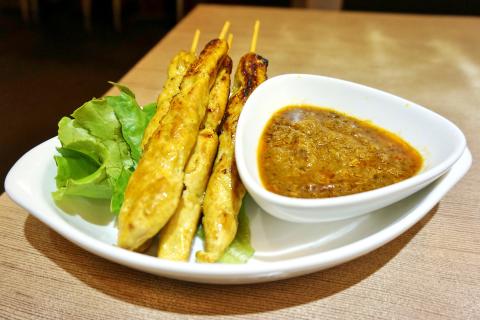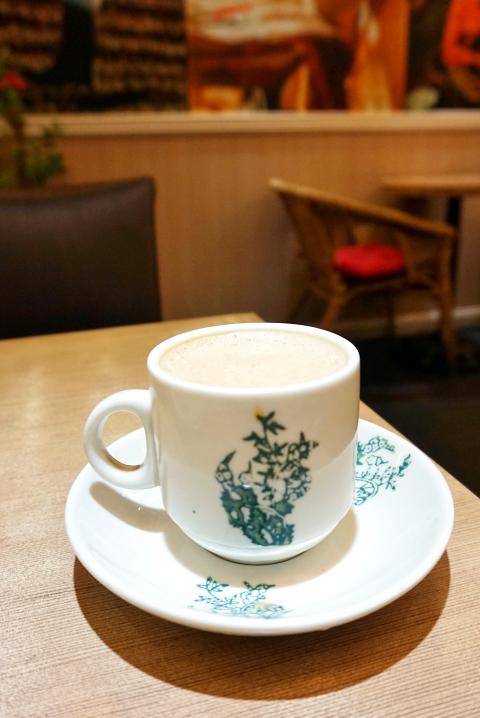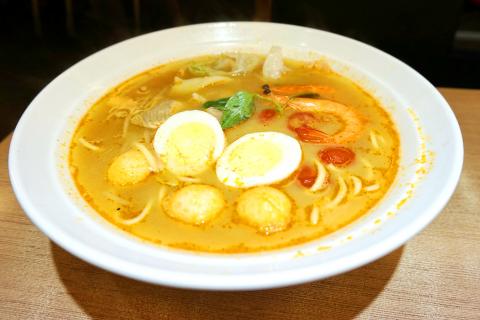From small kampungs (villages) to big cities, it’s not much of a stretch to say that life in Malaysia revolves around food. Strolling down the beaches of Penang or the back alleys in Kuala Lumpur, the noticeable whiff of coconut milk, fish tamarind sauce and tangy aromatic herbs from open-air hawker stalls will beckon. Once in a while, I get sudden cravings for my grandmother’s home-cooked Peranakan food — a fusion cuisine native to the Malacca Strait which combines Chinese ingredients with Malay, Thai and Indian spices — so I end up wandering the streets of Taipei looking for a taste of something remotely similar.
Last week, amid a row of western grills and Shanghai-style eateries on the same road as Taipei American School in Tianmu, I found a “Malaysian” restaurant. White Coffee (白咖啡) is a small shop house furnished with the bare essentials — a few tables and chairs neatly arranged so that it’s not too crowded. The walls are decorated with vintage photographs of old streets in Penang, the home of Peranakan cuisine.
But my heart sank a little when I realized that some of my favorite dishes like beef rendang (chewy shredded beef cooked in coconut milk mixed with spices) and asam laksa (a fish tamarind base soup with white noodles), were absent from the menu. Giving the restaurant the benefit of the doubt though — after all, it’s hard to find these ingredients in Taiwan — I ordered a few other hawker delicacies that Penang is famous for.

Photo: Dana Ter, Taipei Times
First up was the Penang kway teow (NT$190), or flat rice noodles stir-fried with dark soy sauce. In Malaysia, it’s usually cooked with prawns, fish cakes and beansprouts, but at White Coffee, the noodles were mixed with cherry tomatoes, Chinese kale and scrambled eggs, giving it an odd flavor that was soggy and bland at the same time. It was obviously catering to Taiwanese tastes.
To go with my bland kway teow, I ordered an equally bland tom yum noodle soup (NT$180). Although the waitress warned me of the spiciness, it was not the least bit spicy. The first tell-tale sign that it wasn’t authentic was the light yellowish-brown color of the soup. The tastiest tom yum soups are usually a bright orange-red hue and contain a lot of herbs, prawns and mushrooms. The gigantic bowl sitting in front of me, however, only consisted of a few sad-looking eggs and sunken fish balls. The soup was too sweet and murky, lacking basic ingredients like lemongrass, lime and chili flakes which would have introduced some much needed savory flavors into the mixture.
Next up, I had a side of satay (NT$120) — can’t go wrong with grilled chicken on a skewer, right? Not only was the meat a little undercooked, but it also lacked the tangy, charcoaled taste which usually gives satay its kick.

Photo: Dana Ter, Taipei Times
However, I give props to White Coffee for redeeming itself in the toast and coffee department. The kaya and butter toast (NT$60) had a certain butteriness that swirls and melts in your mouth. It was the right type of creamy — not too chunky nor too sweet. The bread was simultaneously soft and crusty, while the burnt edges added a “homely” touch. The kaya and butter toast is best enjoyed with the hot white coffee (NT$70), which is a delightful mixture of sugariness combined with frothy thickness.
All in all, besides their lovely selection of toast and coffee, White Coffee was a disappointing dining experience. Although it is supposed to be a “Malaysian” restaurant, by attempting to blend their dishes with Taiwanese styles of cooking, it just shows how fusion food is hit or miss. If done elegantly, the flavors from different cuisines can complement each other very well. Other times, as in this instance, the result is something that is neither here nor there, not doing justice to either culture’s culinary traditions.
In my opinion, White Coffee would do better if it moved out from the suburbia of Tianmu, set up a branch in the city and marketed itself as a hipster-vintage cafe selling various types of Malaysian-inspired toasts and coffees. If you’re hungry for authentic Malaysian cuisine though, I say book a flight to Southeast Asia for Christmas.

Photo: Dana Ter, Taipei Times

In the March 9 edition of the Taipei Times a piece by Ninon Godefroy ran with the headine “The quiet, gentle rhythm of Taiwan.” It started with the line “Taiwan is a small, humble place. There is no Eiffel Tower, no pyramids — no singular attraction that draws the world’s attention.” I laughed out loud at that. This was out of no disrespect for the author or the piece, which made some interesting analogies and good points about how both Din Tai Fung’s and Taiwan Semiconductor Manufacturing Co’s (TSMC, 台積電) meticulous attention to detail and quality are not quite up to

April 21 to April 27 Hsieh Er’s (謝娥) political fortunes were rising fast after she got out of jail and joined the Chinese Nationalist Party (KMT) in December 1945. Not only did she hold key positions in various committees, she was elected the only woman on the Taipei City Council and headed to Nanjing in 1946 as the sole Taiwanese female representative to the National Constituent Assembly. With the support of first lady Soong May-ling (宋美齡), she started the Taipei Women’s Association and Taiwan Provincial Women’s Association, where she

It is one of the more remarkable facts of Taiwan history that it was never occupied or claimed by any of the numerous kingdoms of southern China — Han or otherwise — that lay just across the water from it. None of their brilliant ministers ever discovered that Taiwan was a “core interest” of the state whose annexation was “inevitable.” As Paul Kua notes in an excellent monograph laying out how the Portuguese gave Taiwan the name “Formosa,” the first Europeans to express an interest in occupying Taiwan were the Spanish. Tonio Andrade in his seminal work, How Taiwan Became Chinese,

Mongolian influencer Anudari Daarya looks effortlessly glamorous and carefree in her social media posts — but the classically trained pianist’s road to acceptance as a transgender artist has been anything but easy. She is one of a growing number of Mongolian LGBTQ youth challenging stereotypes and fighting for acceptance through media representation in the socially conservative country. LGBTQ Mongolians often hide their identities from their employers and colleagues for fear of discrimination, with a survey by the non-profit LGBT Centre Mongolia showing that only 20 percent of people felt comfortable coming out at work. Daarya, 25, said she has faced discrimination since she